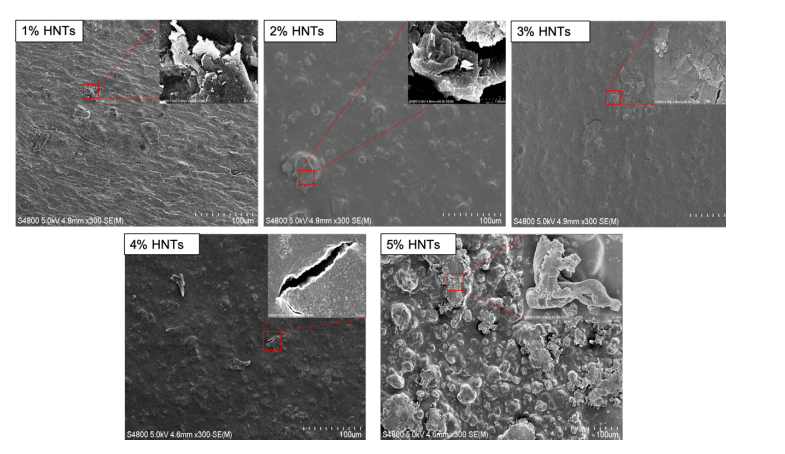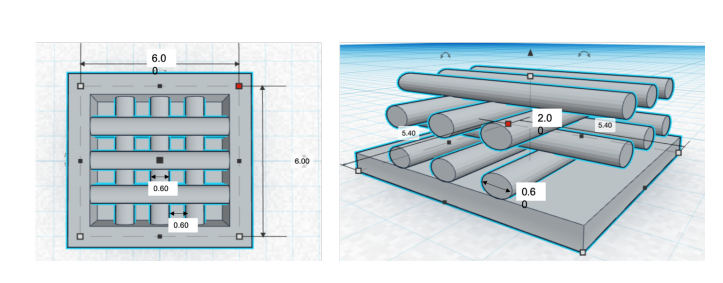Yangyang Luo recently submitted a dissertation, ‘Application of Halloysite Nanotubes in Bone Disease Remediation and Bone Regeneration’ to Louisiana Tech University. Focusing on what can be a very challenging field, Luo looks at new methods for encouraging bone regeneration with customized patient therapy.
Putting together two areas of research and treatment that have offered success to patients in need in recent years, Luo combines both targeted drug delivery and 3D printing to build on patient-specific treatment. Relying on halloysite, an aluminosilicate clay (Al2Si2O5(OH)4nH2O), Luo chose nanotubes (HNTs) built from this material due to biocompatibility and thermal stability.

Halloysite nanotubes structure. The tubular structure formed by the conjunction of silicone dioxide and aluminum oxide layers.
HNTs are already being used in applications like tissue engineering and drug delivery as they are viable for carrying medication that may be sensitive or even toxic. Such drugs can be released exponentially longer than in traditional drug delivery; in fact, HNTs may be released continually for up to 30-100 times longer. They can also be integrated with other chemicals such as vitamins, and the author points out that they have also previously been combined (both in vitro and in vivo) with structures like chitosan-gelatin-agarose hydrogels.
HNTs are affordable, environmentally friendly, and offer ‘abundant storage.’ In this study, Luo used them to deliver medication for treating osteomyelitis, osteosarcoma, and osteoporosis. Chitosan was selected as the medium for the cell growth scaffold due to polycationic properties and potential for antibiotic release, with Gentamicin used as the model drug during experimentation. Both Escherichia coli (E. coli) and Staphylococcus aureus (S. aureus) were used in samples while evaluating the potential for inhibition of bacterial growth.

Live/Dead Assay of cells cultured on CS and CS/HNTs. Compared to control, there are live cells (green) are observed on the film-coated plates, but the number of dead cells (red) has increased as compared with the control plate but remain few in number. This indicates cells can adhere and proliferate on CS and CS/HNTs substrate. However, cellular morphology was influenced by the surface features and physicochemical properties of substrate.
Overall, in combining HNTs to 34 chitosan hydrogel samples, Luo concluded that mechanical properties were improved, and drug release was suitable and effective for decreasing the amount of bacterial growth.
“Our doped clay/chitosan nanocomposite may overcome the limitations of traditional anti-bacterial hydrogels by providing a focal drug delivery and sustained release of drugs, singly or in concert, or a suite of drugs or drug/growth factor combinations,” explained Luo.

SEM images of hydrogel surface that consisted by 5% chitosan and combined with HNTs at different rations (1% to 5%). The pictures in the right corner are the zoom in pictures of the selected areas.
During this study, four different compositions were analyzed:
- PLA
- PLA+HNTs
- PLA+HNTs/Zn
- PLA+HNTs/Zn+Gentamicin
“In order to print them by 3D printer, all the above materials were made into filaments. PLA were extruded by Noztek at 175°C and resulted in the filaments with diameter of 1.75±0.05mm. In order to archive a uniform distribution of HNTs in PLA, 10 µl of silicon oil were added into 20g PLA and vortexed for 10 minutes, then 1.2g of HNTs were added and continually vortexed for another 10 minutes,” explained Luo.

Facile synthesis and characterization of ZnO nanoparticles grown on halloysite nanotubes for enhanced photocatalytic properties.
The samples were printed on an ENDER 3D printer, in disc shapes featuring a diameter of 0.6mm.

Cell adhesion on PLA with three coating strategies. First column is the bright phase. Second column is fluorescent pictures under DAPI filter, which represents cell nucleus. Third column is the fluorescent pictures under FTIC filter, which represents the actin fibers.
Luo reported that surface modification of FBS+NaOH+FBS was responsible for improving PLA hydrophilicity, as well as offering ‘a friendly and attractive surface for cell growth.’ Analysis showed that following a three-week incubation period, early bone formation had begun.
“Even though the coating of gentamicin affected cell growth in early stage, cells recovered from its affection and exhibited a strong osteogenesis in the third week,” concluded Luo. “Furthermore, after 3 weeks storage, it still efficiently restricted bacterial growth.
“In the presence of HNTs, pre-osteoblasts synthesized an early formation of type I collagen matrix and osteocalcin secretion. Gentamicin coating also did not significantly inhibit cell growth. Gentamicin-coated scaffold showed an increased and comparable cell proliferation ability with control groups by day 21. Unexpectedly, pre-osteoblast exhibited a strong osteogenic response in the presence of gentamicin. Therefore, gentamicin-coated PLA/HNTs scaffold could not only prevent bacterial contamination but also promote bone regeneration.”
Researchers are using many different types of materials today as they attempt to find better ways to regenerate bones for patients around the world, from working with hydroxyapatite structures to porous metallic biomaterials, a variety of different coated scaffolds, and more.
What do you think of this news? Let us know your thoughts! Join the discussion of this and other 3D printing topics at 3DPrintBoard.com.
[Source / Images: ‘Application of Halloysite Nanotubes in Bone Disease Remediation and Bone Regeneration’]Subscribe to Our Email Newsletter
Stay up-to-date on all the latest news from the 3D printing industry and receive information and offers from third party vendors.
Print Services
Upload your 3D Models and get them printed quickly and efficiently.
You May Also Like
Consolidation in AM: How 2025 Is Shaping the Industry’s New Normal
The first half of 2025 has been marked by a clear shift in the additive manufacturing (AM) industry. Companies are no longer just focused on developing new tech by themselves....
Etsy Design Rule Change Reduces Selection of 3D Printed Goods
Online marketplace Etsy has implemented a rule change requiring all 3D printed goods on the site to be original designs. The update to the site’s Creativity Standards states, ¨Items produced using...
U.S. Congress Calls Out 3D Printing in Proposal for Commercial Reserve Manufacturing Network
Last week, the U.S. House of Representatives’ Appropriations Committee moved the FY 2026 defense bill forward to the House floor. Included in the legislation is a $131 million proposal for...
Transforming From Tourist to Native: Duro CEO Michael Corr Explains Why the Company Rebuilt its PLM Software on AI
In these early innings of the AI boom, many market analysts have expressed concern that AI spend has gotten too far ahead of the technology’s proven ability to deliver significant...

































